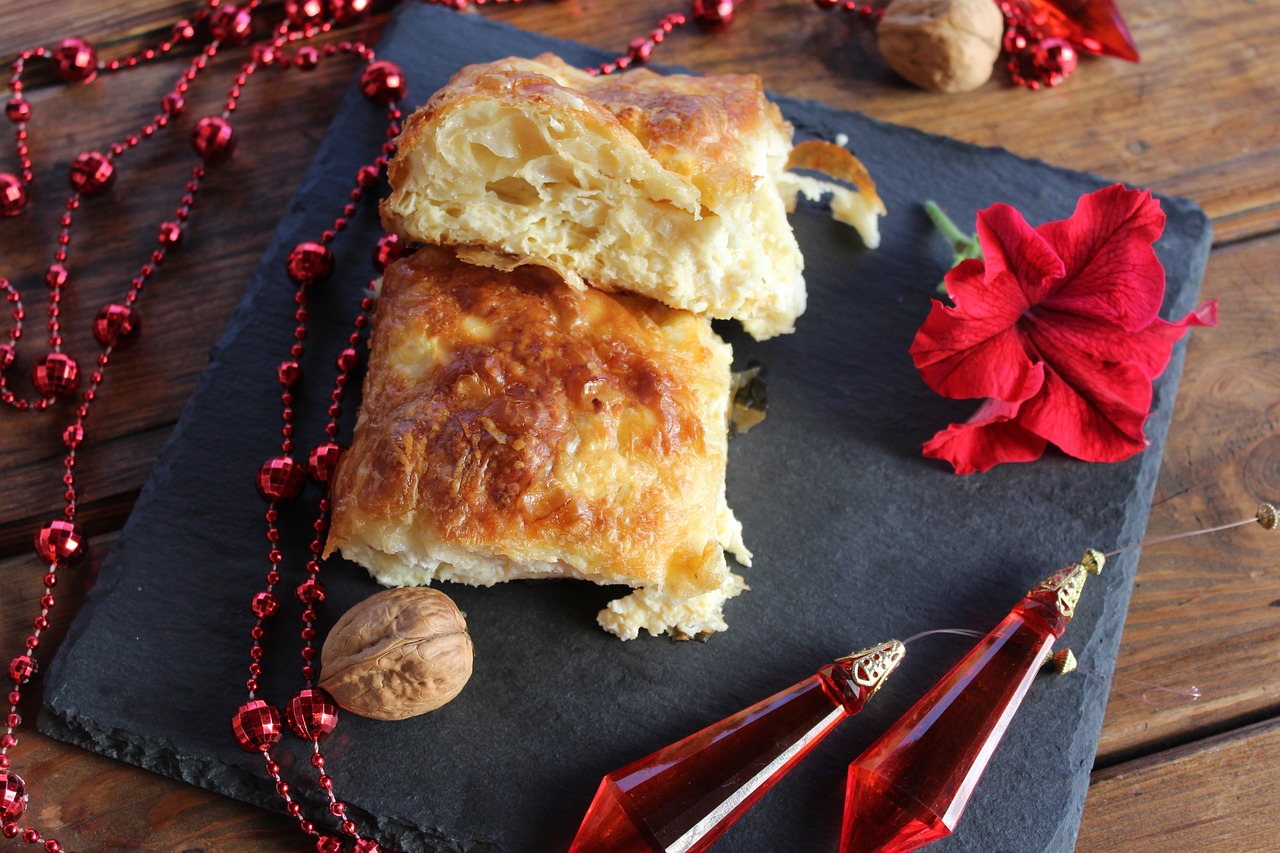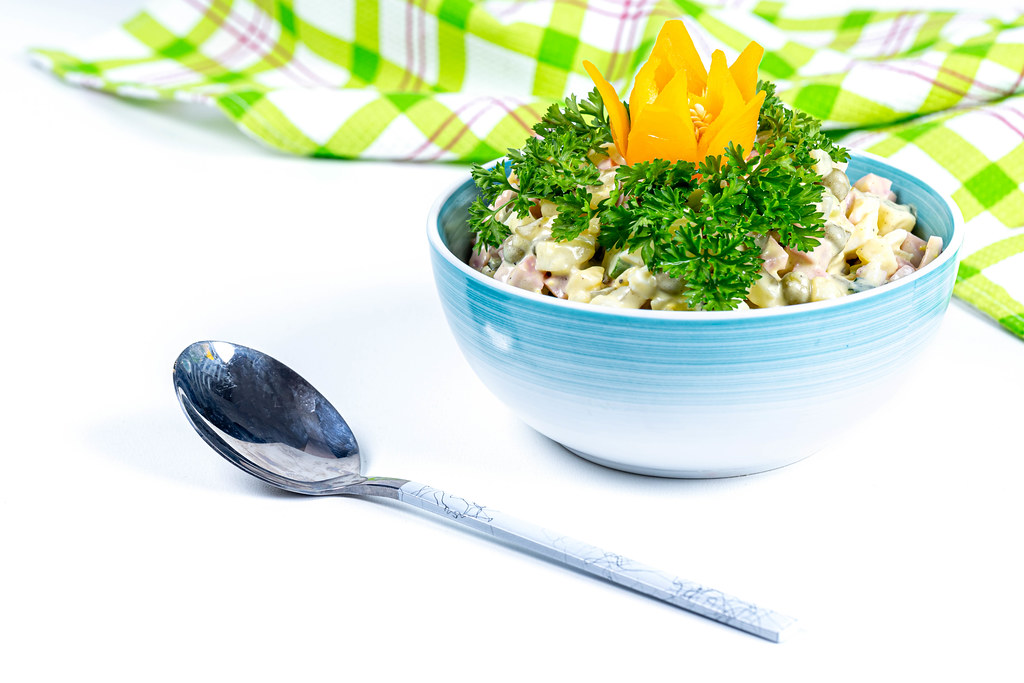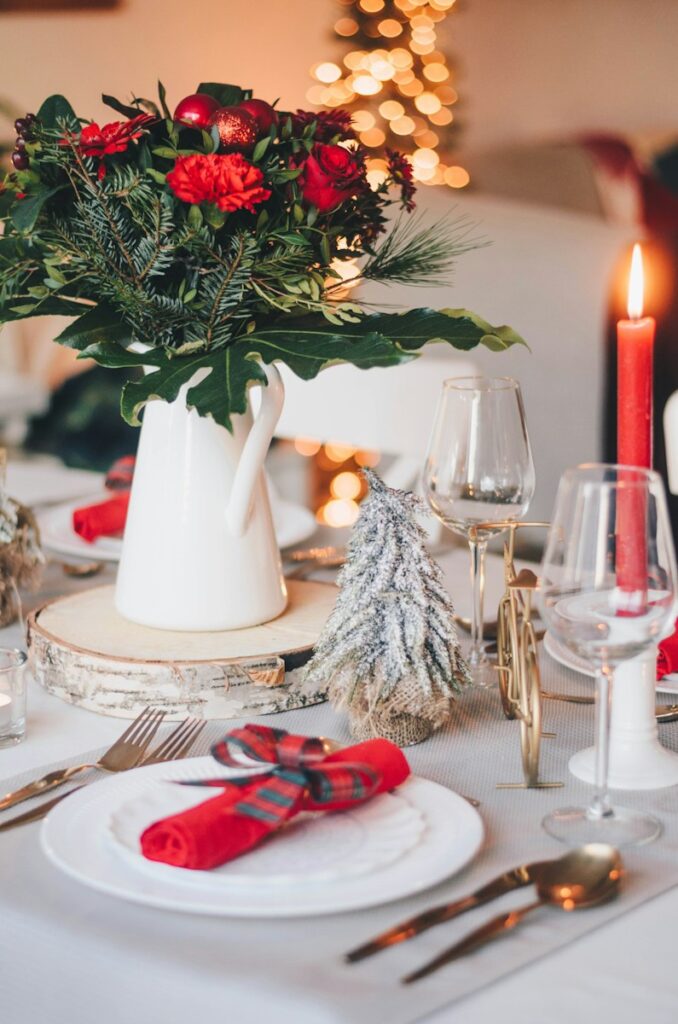Traditional Christmas Dishes in Bulgaria
Christmas is a special time of year in Bulgaria, marked by unique customs, traditions, and, of course, delicious food. The holiday season in this Eastern European country is a time for families to come together and celebrate with a feast of traditional dishes that have been passed down through generations. In this article, we will take a closer look at some of the most beloved and mouthwatering Christmas dishes in Bulgaria.
Bulgarian Christmas cuisine is a fascinating blend of flavours and cultural significance. It is a time when the warmth of the family is intertwined with the rich and diverse tastes of the country. This culinary heritage stretches back centuries, and each dish carries its own story and meaning. The festive table is a reflection of Bulgaria’s history, traditions, and the shared love for good food.
Table of Contents
1. Banitsa
No Bulgarian Christmas table is complete without Banitsa. This savoury pastry is made with thin layers of filo dough filled with a mixture of eggs, white cheese, and sometimes spinach or pumpkin. It is rolled into a spiral shape and baked until golden and crispy. Banitsa symbolizes prosperity and is often enjoyed on Christmas morning. It’s customary for a coin to be hidden inside the Banitsa, and the person who finds it is said to have good luck in the coming year.
Banitsa is not just a pastry; it’s a symbol of the love and abundance that surrounds Christmas in Bulgaria. The delicate layers of filo dough represent the layers of tradition and history, while the rich filling embodies the warmth and unity of the family. Each bite of Banitsa is a journey through time and culture, connecting the present to the past.

2. Kavarma
Kavarma is a hearty stew that consists of meat, usually pork or chicken, and vegetables cooked with plenty of spices and sometimes white wine. The dish is slow-cooked to perfection, allowing the flavours to meld together. Kavarma is often served as the main course on the Christmas table, and it represents the abundance of the harvest and the unity of the family.
Kavarma is a testament to Bulgaria’s agricultural roots and the importance of coming together. The slow cooking process of Kavarma is a symbol of the patience and care that goes into creating this mouthwatering dish. As the aromas waft through the kitchen, they evoke a sense of nostalgia and anticipation, reminding everyone that Christmas is a time of unity and appreciation for the bounties of the land.
3. Kapama
Kapama is another traditional Bulgarian Christmas dish that showcases the rich culinary heritage of the country. It is a slow-cooked casserole made with layers of sauerkraut, rice, and various meats such as pork, chicken, and sometimes lamb. This dish is cooked for hours until all the ingredients become tender and absorb the flavours of the sauerkraut and spices. Kapama symbolizes unity, and it’s believed that the more types of meat used, the more prosperous the coming year will be.
Kapama is not just a dish; it’s a labor of love and tradition. The layers of sauerkraut and rice represent the bonds that hold families together. As the flavours meld, the dish becomes a testament to the patience and care that go into preserving Bulgarian traditions. Kapama brings together the old and the new, creating a symphony of taste that resonates with the history of the country.
4. Ruska salata (Russian salad or Salad Olivier)
Ruska salata, also known as Russian salad or Olivier salad, is a popular side dish at Bulgarian Christmas dinners. This colorful salad is made with diced boiled potatoes, carrots, peas, pickles, and mayonnaise, and it is often garnished with hard-boiled eggs and parsley. Ruska salata adds a refreshing contrast to the rich and hearty main dishes and is a symbol of the joy and celebration that comes with the holiday season.
Ruska salata is a culinary delight that brings a burst of colour and freshness to the Christmas table. The diced vegetables are like little gems, representing the diversity and vibrancy of life. As the mayonnaise binds the ingredients together, it’s a reminder that Christmas is a time when family and friends come together, creating a harmonious and joyful atmosphere.

5. Zeleva Supa
Zeleva Supa is a traditional Bulgarian cabbage soup that is served on Christmas Eve. This soup is made with sauerkraut, fresh cabbage, and various vegetables, creating a delicious and comforting broth. It’s traditionally believed to bring good health and fortune in the coming year. In some regions of Bulgaria, it’s also customary to add a coin to the soup, and the person who finds it will have good luck.
Zeleva Supa is more than just a bowl of soup; it’s a culinary tradition that nourishes both body and soul. The sauerkraut and fresh cabbage are like a metaphor for the cycle of life, with the warmth of the soup embracing the hope for a better year ahead. The coin hidden within is a tangible symbol of the wish for good fortune, reminding everyone that Christmas is a time for optimism and well-being.
6. Oshav
Oshav is a traditional Bulgarian Christmas drink made from dried fruits, usually apples, pears, and plums. These fruits are soaked in water and boiled with sugar and spices to create a sweet and aromatic beverage. Oshav is typically served in a small glass and enjoyed with the Christmas meal. It is believed to symbolize the sweetness of life and the hope for a prosperous future.
Oshav is a drink that embodies the essence of Christmas in Bulgaria. The dried fruits represent the past, with their rich and preserved flavours. As they are rehydrated and simmered with spices, it’s a reflection of the warmth and hope that the holiday season brings. Each sip of Oshav is a toast to the good times and the promise of a bright future.
7. Pogacha
Pogacha is a round, flat bread that holds a special place in Bulgarian Christmas traditions. It is usually baked with a decorative pattern on top, which can vary from region to region. Pogacha is a symbol of unity and sharing, and it is often torn into pieces and shared among family members during the Christmas meal.
Pogacha is more than just bread; it’s a symbol of the togetherness that defines the holiday season. The decorative patterns on top tell a story of the region and the family that bakes it, showing that traditions can be passed down in various forms. Breaking and sharing Pogacha is a ritual that brings everyone closer, emphasizing that Christmas is a time for unity and connection.

8. Medenki
Christmas in Bulgaria wouldn’t be complete without Medenki, which are honey cookies. These small, sweet treats are made with honey, sugar, and a blend of spices, such as cinnamon and cloves. Medenki are often shaped like hearts, stars, or other festive symbols and are a delightful addition to the holiday table. They are a symbol of love and sweetness in life.
Medenki are more than just cookies; they are a reflection of the love and sweetness that fills the air during Christmas. The honey and spices are like a warm embrace, reminding everyone that the holiday season is a time to share affection and joy. Shaped into festive symbols, Medenki are a visual representation of the holiday spirit, and each bite is a reminder of the love that binds families and friends together during this special time.
9. Tikvenik
Tikvenik is a mouthwatering dessert that takes center stage during the Bulgarian Christmas celebration. This pastry is made with layers of thin filo dough filled with a sweet and spiced pumpkin filling. It’s rolled into a log shape and baked until golden brown. Tikvenik is a symbol of the harvest and the hopes for a bountiful year ahead.
Tikvenik is more than just a dessert; it’s a celebration of the harvest and the promise of a prosperous future. The layers of filo dough represent the passing of time, with the pumpkin filling symbolizing the fruits of the earth. The act of rolling and baking Tikvenik is a metaphor for the turning of the seasons and the anticipation of a new year filled with abundance.
In Bulgaria, Christmas is a time of joy, togetherness, and, of course, delicious food. The traditional Christmas dishes we’ve explored in this article are not just a source of sustenance but also carry deep cultural and symbolic significance. They represent the hopes and wishes for a prosperous and harmonious future, as well as the importance of family and tradition.
As you sit down to enjoy your Bulgarian Christmas feast, remember that each dish tells a story and carries with it the spirit of the holiday season. Whether it’s the savoury Banitsa, the rich Kavarma, or the sweet Medenki, these traditional dishes are a testament to the culinary heritage and the warmth of Bulgarian Christmas traditions. So, savour every bite and cherish the time spent with loved ones during this magical time of year.
Bulgarian Christmas cuisine is a treasure trove of flavours, traditions, and shared experiences. It reflects the country’s deep history and the importance of coming together as a family and a community. Each dish on the Christmas table is a symbol of love, unity, and the hope for a brighter future.
This Christmas, whether you are in Bulgaria or anywhere else in the world, you can take inspiration from these traditional dishes to create a special holiday atmosphere. Embrace the flavours, the traditions, and the symbolism behind each dish, and make your Christmas celebration a time of love, togetherness, and delicious food. After all, the true magic of Christmas is not just in the presents under the tree but in the warmth and connection shared at the dinner table.
Bulgarian Christmas cuisine is a vibrant tapestry of tradition and innovation, reflecting the country’s rich cultural heritage and its openness to modern culinary influences. As the holiday season approaches, the focus on Christmas dishes in Bulgaria has evolved, leading to several fascinating trends. In this article, we’ll explore 10 trending topics in Bulgarian Christmas cuisine, each providing insight into how this cherished tradition is adapting to contemporary tastes and preferences.
Modern Twists on Traditional Christmas Dishes
One of the most prominent trends in Bulgarian Christmas cuisine is the fusion of modern culinary techniques with traditional recipes. Both professional chefs and home cooks are reimagining classic dishes, adding innovative twists to create exciting variations. For example, the traditional savory Banitsa can now be found in sweet versions, featuring fillings like chocolate and berries. These modern interpretations offer a fresh perspective on familiar flavours, making them appealing to a new generation of food enthusiasts.
The modern twist on traditional dishes showcases the adaptability of Bulgarian Christmas cuisine. It’s a reflection of how the culinary heritage is evolving to meet contemporary tastes and preferences while preserving the core essence of these beloved recipes.
Vegan and Vegetarian Options for a Plant-Based Christmas
The rise of plant-based diets is not limited to the rest of the year; it has significantly influenced how Bulgarians celebrate Christmas. The demand for vegan and vegetarian Christmas dishes is on the rise. Savvy cooks are developing creative plant-based versions of traditional holiday recipes, ensuring that those who follow meatless diets can enjoy a festive meal without compromise.
This trend highlights the inclusivity of Bulgarian Christmas cuisine. It caters to a diverse range of dietary choices and ensures that no one is left out during this special season of sharing and togetherness.
Regional Variations in Christmas Cuisine
Bulgaria’s diverse regions each have their own unique culinary traditions, and Christmas is no exception. From the hearty Kavarma of the Rhodope Mountains to the Kapama of the Balkan region, these regional variations offer a tantalizing journey through the country’s diverse culinary landscape.
The interest in regional variations not only brings attention to the culinary diversity of Bulgaria but also serves as a source of national pride. It’s an acknowledgment that the richness of the country’s cuisine cannot be confined to a single recipe or tradition.

The Role of Bulgarian Christmas Food in Cultural Identity
For Bulgarians, Christmas food is not just about nourishment; it’s a reflection of cultural identity and a shared sense of belonging. Preparing and sharing traditional dishes during the holiday season is a way to pass down cultural heritage to the younger generations. The trend of emphasizing the cultural significance of these dishes is making Christmas more than just a meal; it’s a time to connect with one’s roots and celebrate a shared history.
This trend underscores the deep cultural importance of Bulgarian Christmas cuisine. It’s a reminder that the food on the holiday table is more than just sustenance; it’s a connection to the past and a way to honour and celebrate the traditions of the country.
The Impact of Globalization on Christmas Menus
The world is more interconnected than ever before, and this has a noticeable influence on Bulgarian Christmas menus. Globalization introduces new ingredients and culinary influences to the holiday table. You can now find international twists on traditional Bulgarian dishes, as well as new, globally-inspired recipes that have become a part of the holiday tradition. This blending of culinary cultures adds a dynamic dimension to the celebration.
The impact of globalization is a testament to the adaptability of Bulgarian Christmas cuisine. It demonstrates the country’s openness to the world, as well as its willingness to incorporate diverse influences into a cherished tradition.
Christmas Food and Sustainable Practices
Sustainability is a growing concern across the globe, and it has now extended to the realm of Christmas cuisine. Locally sourcing ingredients, reducing food waste, and adopting sustainable cooking practices are becoming increasingly important to Bulgarians during the holiday season. There is a focus on using seasonal, locally-grown produce and minimizing the environmental impact of the Christmas feast.
This trend is a reflection of the values held dear by Bulgarians. It’s an affirmation of the country’s commitment to sustainable practices and ensuring that the Christmas celebration leaves a positive impact on the environment.
Culinary Tourism and Bulgarian Christmas Food
Bulgaria’s unique Christmas cuisine has begun to attract culinary tourists from around the world. This trend sees travellers exploring Bulgaria during the holiday season to immerse themselves in the culture and taste the traditional dishes firsthand. The opportunity to experience the warmth of Bulgarian hospitality, along with the flavours of Christmas, is an alluring draw for visitors seeking an authentic holiday experience.
The growth of culinary tourism is a testament to the appeal of Bulgarian Christmas cuisine. It’s an acknowledgment that the country’s culinary traditions are not only cherished by locals but also highly regarded by global food enthusiasts.
Online Cooking Classes and the Popularization of Christmas Recipes
The internet has made it easier than ever to share knowledge, and Christmas recipes are no exception. Online cooking classes have gained popularity, allowing people to learn how to prepare Bulgarian Christmas dishes from the comfort of their own homes. This trend makes traditional recipes more accessible to a wider audience, including those living abroad who want to keep their Bulgarian culinary traditions alive.
The availability of online cooking classes ensures that Bulgarian Christmas cuisine can be passed down to future generations, regardless of geographical boundaries. It’s a testament to the enduring love for these traditional dishes.
Health and Wellness Trends in Christmas Dining
The health and wellness movement has seeped into holiday dining as well. Bulgarians are increasingly conscious of their dietary choices and are seeking healthier options even during Christmas. Traditional recipes are being adapted to align with these health and wellness trends. This includes offering low-sugar, gluten-free, and low-fat alternatives, ensuring that everyone can partake in the festivities without compromising their dietary restrictions.
This trend reflects the desire for inclusivity in Bulgarian Christmas cuisine. It ensures that no one has to forgo their health and dietary considerations during the holiday season.
The Digital Influence on Christmas Food Photography and Social Media
Social media has become a platform for showcasing culinary traditions. The trend of sharing Christmas dishes on platforms like Instagram and Pinterest has given rise to a new appreciation for the aesthetics of Bulgarian Christmas cuisine. Photographers and food enthusiasts are capturing the beauty of these dishes, turning them into works of art. As a result, not only are more people interested in tasting Bulgarian Christmas food, but they’re also inspired to prepare and present these dishes with a creative and artistic touch.
The digital influence on food photography and social media is a reflection of the evolving food culture in Bulgaria. It demonstrates the creativity and innovation that is being injected into the presentation of these traditional dishes.
Bulgarian Christmas cuisine is evolving and adapting to the changing tastes and preferences of the modern era. While it remains firmly rooted in tradition, these trending topics reflect the dynamic nature of the country’s culinary traditions. From modern twists on classic dishes to the revival of forgotten recipes and the fusion of Bulgarian and international flavors, the Christmas table is a testament to Bulgaria’s rich and diverse culinary heritage.
As the holiday season approaches, Bulgarians and food enthusiasts around the world can anticipate an exciting blend of tradition and innovation on their Christmas plates.